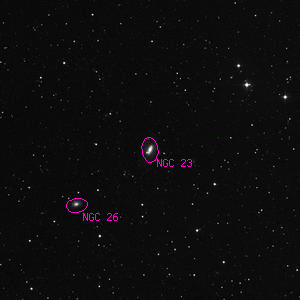NGC 23

Overlaid DSS image of NGC 23, 30' x 30' with north at top and west to the right
Aladin viewer for the region around NGC 23
| Type | Galaxy |
|---|---|
| Magnitude | 12 |
| Size | 2.5' x 1.6' @ 8° |
| Right Ascension | 0h 9' 53.4" (2000) |
| Declination | 25° 55' 26" N |
| Constellation | Pegasus |
| Description | 3 S st + neb |
| Classification | SBa |
Observing Notes
Captain William Henry Smyth
Oct 23, 1836 No. 6 The Crescent, Bedford, England (map)
150mm f/17.6 refractor by Tully 1827
A double star in a coarse cluster, occupying the spot where I looked for Sir William Herschel's faint nebula [NGC 23]. A 10, and B 11, both pale blue. It lies on the crown of Andromeda's head, and about 3 south of the star a. I saw none of the nebulosity alluded to by Sir William in his registry of 1784, but a perceptible glow in a tolerably rich and darkened field was indicative of nebulous matter.
This part was followed by three principal stars nearly in a line at almost equal distances, and each with a companion np. The third being the smallest and closest, is here estimated. Another double star follows in the upper part of the field, at about three minutes Δ RA.
If this glow really be a mass of that self-shining element, or modification of matter, which Sir William Herschel has taught us to recognise as being a thin filmy substance diffused in the vast regions of space, it must be at an astounding distance from our system.
Sir William only considered that he could here perceive nebulous fluid, but neither his instrument, nor any other yet constructed, has sufficed to give it a distinct form, let alone a resolvable aspect. From every indication, and inductive analogy, the numerous small stars perceivable in the field are posited between us and the nebulosity: it must therefore be at a degree of remoteness, which cannot be expressed in language.
There are some of the star-gazing class, who would consider such a shadowy pellicle as barely worth enrolment; but to the superior order of observers it is a most important object, both for scrutiny and study, in our present ignorance of the nature of this self-luminous substance. To the astronomer of a future day, it may offer a more condensed aspect.― A Cycle of Celestial Objects Vol II, The Bedford Catalogue, William Henry Smyth, 1844
Other Data Sources for NGC 23
Nearby objects for NGC 23
Credits...
Drawings, descriptions, and CCD photos are copyright Andrew Cooper unless otherwise noted, no usage without permission.
A complete list of credits and sources can be found on the about page
NGC 23